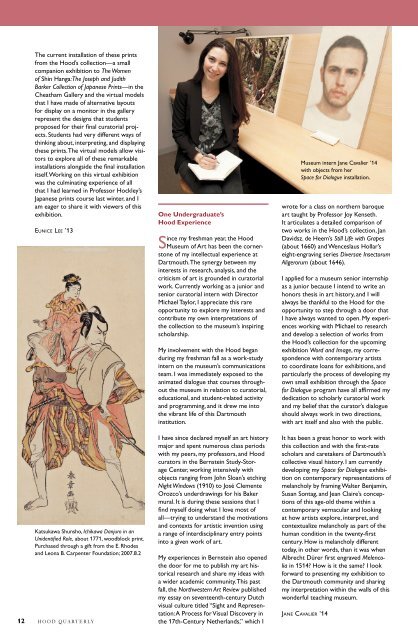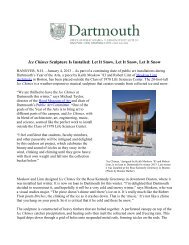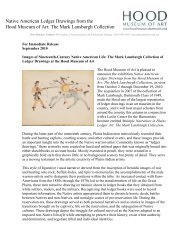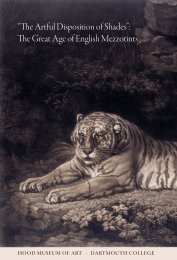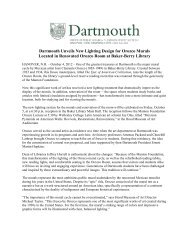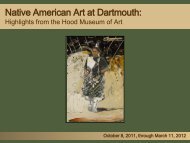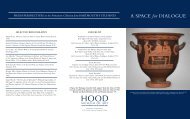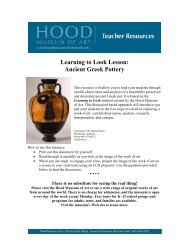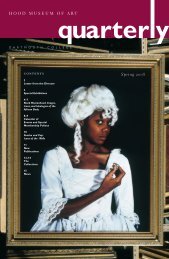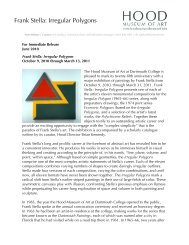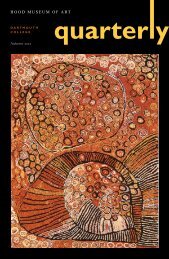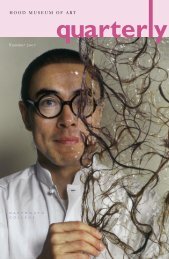Spring 2013 - Hood Museum of Art - Dartmouth College
Spring 2013 - Hood Museum of Art - Dartmouth College
Spring 2013 - Hood Museum of Art - Dartmouth College
- No tags were found...
Create successful ePaper yourself
Turn your PDF publications into a flip-book with our unique Google optimized e-Paper software.
The current installation <strong>of</strong> these prints<br />
from the <strong>Hood</strong>’s collection—a small<br />
companion exhibition to The Women<br />
<strong>of</strong> Shin Hanga: The Joseph and Judith<br />
Barker Collection <strong>of</strong> Japanese Prints—in the<br />
Cheatham Gallery and the virtual models<br />
that I have made <strong>of</strong> alternative layouts<br />
for display on a monitor in the gallery<br />
represent the designs that students<br />
proposed for their final curatorial projects.<br />
Students had very different ways <strong>of</strong><br />
thinking about, interpreting, and displaying<br />
these prints. The virtual models allow visitors<br />
to explore all <strong>of</strong> these remarkable<br />
installations alongside the final installation<br />
itself. Working on this virtual exhibition<br />
was the culminating experience <strong>of</strong> all<br />
that I had learned in Pr<strong>of</strong>essor Hockley’s<br />
Japanese prints course last winter, and I<br />
am eager to share it with viewers <strong>of</strong> this<br />
exhibition.<br />
Eunice Lee ’13<br />
Katsukawa Shunsho, Ichikawa Danjuro in an<br />
Unidentified Role, about 1771, woodblock print.<br />
Purchased through a gift from the E. Rhodes<br />
and Leona B. Carpenter Foundation; 2007.8.2<br />
12 H O O D Q U A R T E R L Y<br />
One Undergraduate’s<br />
<strong>Hood</strong> Experience<br />
Since my freshman year, the <strong>Hood</strong><br />
<strong>Museum</strong> <strong>of</strong> <strong>Art</strong> has been the cornerstone<br />
<strong>of</strong> my intellectual experience at<br />
<strong>Dartmouth</strong>. The synergy between my<br />
interests in research, analysis, and the<br />
criticism <strong>of</strong> art is grounded in curatorial<br />
work. Currently working as a junior and<br />
senior curatorial intern with Director<br />
Michael Taylor, I appreciate this rare<br />
opportunity to explore my interests and<br />
contribute my own interpretations <strong>of</strong><br />
the collection to the museum’s inspiring<br />
scholarship.<br />
My involvement with the <strong>Hood</strong> began<br />
during my freshman fall as a work-study<br />
intern on the museum’s communications<br />
team. I was immediately exposed to the<br />
animated dialogue that courses throughout<br />
the museum in relation to curatorial,<br />
educational, and student-related activity<br />
and programming, and it drew me into<br />
the vibrant life <strong>of</strong> this <strong>Dartmouth</strong><br />
institution.<br />
I have since declared myself an art history<br />
major and spent numerous class periods<br />
with my peers, my pr<strong>of</strong>essors, and <strong>Hood</strong><br />
curators in the Bernstein Study-Storage<br />
Center, working intensively with<br />
objects ranging from John Sloan’s etching<br />
Night Windows (1910) to José Clemente<br />
Orozco’s underdrawings for his Baker<br />
mural. It is during these sessions that I<br />
find myself doing what I love most <strong>of</strong><br />
all—trying to understand the motivations<br />
and contexts for artistic invention using<br />
a range <strong>of</strong> interdisciplinary entry points<br />
into a given work <strong>of</strong> art.<br />
My experiences in Bernstein also opened<br />
the door for me to publish my art historical<br />
research and share my ideas with<br />
a wider academic community. This past<br />
fall, the Northwestern <strong>Art</strong> Review published<br />
my essay on seventeenth-century Dutch<br />
visual culture titled “Sight and Representation:<br />
A Process for Visual Discovery in<br />
the 17th-Century Netherlands,” which I<br />
<strong>Museum</strong> intern Jane Cavalier ’14<br />
with objects from her<br />
Space for Dialogue installation.<br />
wrote for a class on northern baroque<br />
art taught by Pr<strong>of</strong>essor Joy Kenseth.<br />
It articulates a detailed comparison <strong>of</strong><br />
two works in the <strong>Hood</strong>’s collection, Jan<br />
Davidsz. de Heem’s Still Life with Grapes<br />
(about 1660) and Wenceslaus Hollar’s<br />
eight-engraving series Diversae Insectorum<br />
Aligerorum (about 1646).<br />
I applied for a museum senior internship<br />
as a junior because I intend to write an<br />
honors thesis in art history, and I will<br />
always be thankful to the <strong>Hood</strong> for the<br />
opportunity to step through a door that<br />
I have always wanted to open. My experiences<br />
working with Michael to research<br />
and develop a selection <strong>of</strong> works from<br />
the <strong>Hood</strong>’s collection for the upcoming<br />
exhibition Word and Image, my correspondence<br />
with contemporary artists<br />
to coordinate loans for exhibitions, and<br />
particularly the process <strong>of</strong> developing my<br />
own small exhibition through the Space<br />
for Dialogue program have all affirmed my<br />
dedication to scholarly curatorial work<br />
and my belief that the curator’s dialogue<br />
should always work in two directions,<br />
with art itself and also with the public.<br />
It has been a great honor to work with<br />
this collection and with the first-rate<br />
scholars and caretakers <strong>of</strong> <strong>Dartmouth</strong>’s<br />
collective visual history. I am currently<br />
developing my Space for Dialogue exhibition<br />
on contemporary representations <strong>of</strong><br />
melancholy by framing Walter Benjamin,<br />
Susan Sontag, and Jean Claire’s conceptions<br />
<strong>of</strong> this age-old theme within a<br />
contemporary vernacular and looking<br />
at how artists explore, interpret, and<br />
contextualize melancholy as part <strong>of</strong> the<br />
human condition in the twenty-first<br />
century. How is melancholy different<br />
today, in other words, than it was when<br />
Albrecht Dürer first engraved Melencolia<br />
in 1514 How is it the same I look<br />
forward to presenting my exhibition to<br />
the <strong>Dartmouth</strong> community and sharing<br />
my interpretation within the walls <strong>of</strong> this<br />
wonderful teaching museum.<br />
Jane Cavalier ’14


